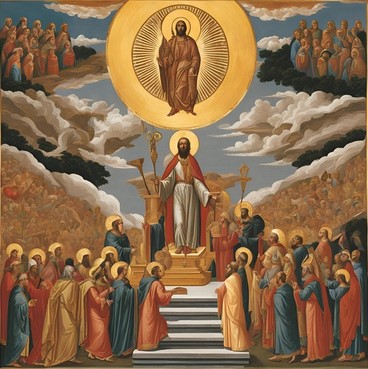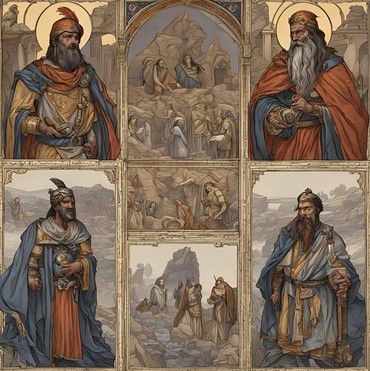“When we beheld the Great Pantheum of Iulianopolis, before it we made three great sacrifices in thanks; to Brahma Fabricator, for our wealth, to Mercurius Sobrius for our safety on the road, and to Mithras Tauroktonos for our honest kin.”
-Journal of a Syrian merchant
Where there reside men, there reside gods. Gods defend all beings, having before partitioned the earth to their liking, and granted all gifts and curses to the world. Gods who wrote the natural laws, by which all must follow, even the most rebellious and strong-willed, for no king may command the rise of the tides, the fall of leaves, and the growth of pastures. No king may conquer the gryphons that fly, the krakens that swim, the bears that roam, for they serve masters higher and more powerful than any king may imagine themselves to be, even the prideful master of Halicarnassus.
Persia, foremost, seems to be the land of gods. From the center land through which all trade must flow, Persia gathers all the superstitious and pious into one land, and spreads them outwards to all the roads that emerge from it. The emperor of Persia has given himself to the god known as Hormazd, who is the highest of all the gods, who is caretaker of wisdom itself and writ into the stars the law of magic and nature. Below Hormazd are his loyal slaves, called Yazatas, who care in part for the world and its functions. Greatest among them are Sarosh, Mihr, and Rashn, who each in part care for the dead, as well as Bahram and Tir, who serve their master in war. His brother and foe is the vile Ahriman, whose slaves the Daevas are equal in number and strength to the Yazatas, but seek the destruction of all that is good. The Persian worshippers hold the three elements of fire, water, and magic in highest regard, and build grand temples within which they may be housed and kept pure. The college that keeps the cult of Hormazd, the Mobads, are strictly open to those skilled in the art of commanding magic.
Elsewhere in Persia is the worship of Mani’s god, the practice of which is forbidden both in Persia and in most of the world beyond. The priest Mani held a god known as Zurvan up to the highest rather than Hormazd, and below him are his sons, who Mani’s superstitious believe to be the gods of all other cults. His foe is the Darkness, known by many names, and their spawn, who entrapped the world of the mind in the world of flesh and of the physical. Thus, it is the view of the cult of Mani that wisdom is the mind attempting to escape from its prison the body, and respect highly the act of death. Mani’s cult demonstrates clear derivations from more ancient cults, which they justify by claiming that all cults before are simply imperfect observations of the great truth, and all cults after are corruptions of the truth already granted.
East of Persia lies the empire of Chandragupta, who has dared to claim all of India for himself. He has dedicated himself to the god Vishnu, who preserves the balance of the world, and alongside his two brothers Brahma and Shiva are responsible for writing the laws of nature. Below them are a number of other gods and daemons, greatest among them being Ganga, Shakti, Ganesha, and Aditya, although Emperor Chandragupta allows the worship of cults to each of them, some of whom proclaim their own gods to be above Vishnu himself. The priestly body of Vishnu, called the Brahmins, are called often to be personal advisors on all matters to the emperor, and are known to conduct themselves strictly, studying many earthly matters and rejecting the consumption of meat, fish, and eggs. Despite this, the gods of India have been known to accept the sacrifice of animals, especially that of horses, the practice of which is associated with royal legitimacy.
India is also the origin of the mystery cult of Buddha, which worships a number of gods who had through great study and the rejection of hedonism and lavishness ascended from mankind, and calls their adherents to do the same. Some consider Vishnu and the more ancient gods of India to as well be ascended men, and make sacrifices to them in much the same manner as the Gupta lords. Despite the rejection of personal wealth, the cult of Buddha has been known to construct great and magnificent temples, equaling or exceeding that of other gods in their splendor, and receiving the patronage of great kings. Another cult, that of Jain, grows in prominence in the same region, much similar in many ways, but which is strange in the idea that their practitioners believe that all peoples are themselves gods, or that there are no gods at all.
West of Persia is the lands of Rome, wherein the emperor has proclaimed a mandate recognizing the sun as the foremost and highest of all gods, and from which all things emanate. The imperial cult equates the sun, which they call Sol Inuictus, to be equated as well with other grand concepts as logic, the universe, magic, and goodness. Sol has very recently, within the Roman world, usurped an older god by the name of Iuppiter as foremost of all gods and daemons, and many subjects of the Roman emperor continue to venerate Iuppiter before Sol, as father or kinsman of each of the other gods now decreed as lesser. Below either Sol or Iuppiter are a number of lesser gods, greatest among them holding rulership over some portion of the world and its forces, including Neptunus, god of the seas, Dispater, god of the earth, Diana, goddess of beasts, and Minerua, goddess of wars. The Roman religion is rarely strict in its practice, often adding the gods of their conquered people as siblings or children of the gods they already worship, yet with the recent upheaval that practice has swiftly waned.
South of Persia is the grand empire of Axum and its ring of clients, who worship the cult of Christ, which has been banned in both Rome and Persia and not for the first time. Unlike the other religions, the followers of Christ do not believe in a single great god ruling over lesser gods, but either a pair or a triumvirate of gods, who share the task of managing all the universe between themselves. One, the elder god (who to the Christians is nameless), shares its worship with the cult of Iudea, although the two cults despise each other fiercely. The younger god is called Joshua Christos, or Galileo (by his place of birth), and is the son of the elder god by an Israelite woman, or alternatively the elder god himself having been birthed through an Israelite woman. Occasional practices recognize a third or fourth god, they being the Sacred Form, which is again often interpreted as the elder god by another face, and a vile god called Shaytan or Diabolos.



